As part of my work as a PhD student, I read lots of papers about open innovation and/or participative marketing. These papers are highly interesting but, I must admit, sometimes a little repelling with huge chunks of texts, references and citations. Visualizations of the described phenomena are greatly helpful to understand some of this information… I thought it would be interesting to gather a couple of visualizations of my research interests: crowdsourcing, co-creation and open innovation in a blog post ! This is not only quite entertaining, but might help people out there find new sources. Here we go… [this post was last updated on October 6th 2015]
-
CROWDSOURCING
Crowdsourcing has first been defined as “the act of a company or institution taking a function once performed by employees and outsourcing it to an undefined (and generally large) network of people in the form of an open call” (Howe, 2006). I particularly like the end of the definition (the open call part) and I don’t think that the term can be applied to everything that is peer-produced or web-based, as more and more people do. The crowdsourcing process is, as Brabham (2010) notes “sponsored by an organization, and that […] directed or managed by this organization throughout the process. This is very different from, say, the online encyclopedia project Wikipedia, where an open space exists for individuals to work collaboratively“.
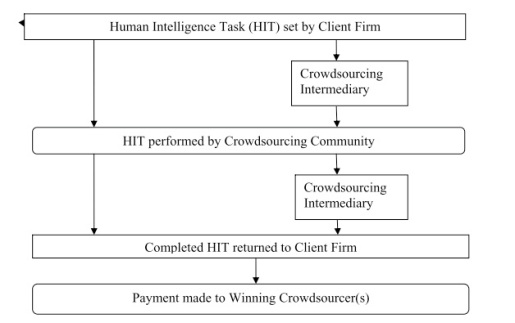
Whitla, P. (2009). Crowdsourcing and Its Application in Marketing Activities. Contemporary Management Research, 5(1), 15-28
In a paper about crowdsourcing‘s application in marketing activities, Paul Whitla from Lingnan University gives three main marketing-related areas that can benefit from crowdsourcing: product development, advertising & promotion, and marketing research. The above representation is just a generic description of the crowdsourcing process, with crowdsourcing intermediaries such as Cambrian House, Mechanical Turk, iStockphoto, Mob4hire, Crowdspirit, Kluster, NineSigma, InnoCentive or Filmriot. Some of them don’t exist anymore ! A propos marketing-related areas impacted by crowdsourcing, you might want to read this: The Implications of User-Generated Advertising on the Value Chain of Advertising.
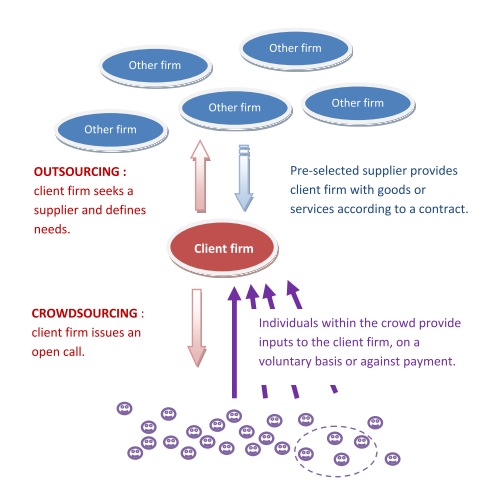
Schenk, E., & Guittard, C. (2010). Towards a characterization of crowdsourcing practices. Journal of Innovation Economics, 7(1), 1-20.
The above visulization is drawn from a paper I recently discovered. It comparesoutsourcing to crowdsourcing and emphasizes how the latter is a concept per se, distinct from User Innovation, Open Innovation or the Open Source movement. Going a little further, the authors distinguish crowd-based applications like Yelp or Captcha, which they call Integrative Crowdsourcing, and crowdsourced problem-solving like InnoCentive or Nokia Calling All Innovators, which they call Selective Crowdsourcing. Besides, they make a very useful distinction between the type of tasks that are being crowdsourced: simple tasks, complex tasks and creative tasks (see here).
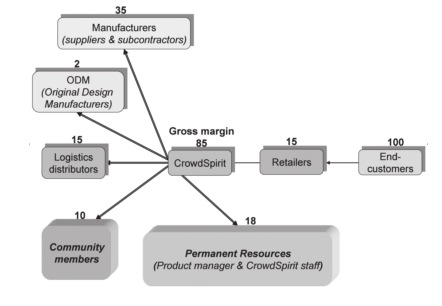
Chanal, V., & Caron-Fasan, M.-L. (2010). The Difficulties Involved in Developing Business Models Open to Innovation Communities: The Case of a Crowdsourcing Platform. Management, 13(4), 318-340
Another very interesting visualization is the one above, that explains how the crowd-based community platform CrowdSpirit (which failed) planned to share revenue with its partners – among which was the crowd. I know it’s not a proper view of the crowdsourcing process, but I really like it because it (like the whole paper) offers rare insights into the difficult world of profitability 😉 It also shows that ideas might be free, but generating revenue from these ideas is tricky !
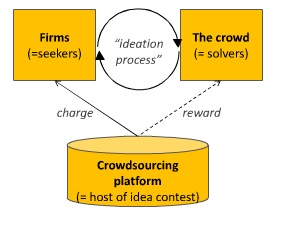
Walter, T., & Back, A. (2011). TOWARDS MEASURING CROWDSOURCING SUCCESS: AN EMPIRICAL STUDY ON EFFECTS OF EXTERNAL FACTORS IN ONLINE IDEA CONTEST. 6th Mediterranean Conference on Information Systems (MCIS). Limassol, Cyprus. Retrieved from http://slidesha.re/qDV7Yj
For those who want to find out more about this illustration, they can check out this Slideshare presentation about the Swiss ideation-platform Atizo. Similarly to Lakhani & Jeppesen’s paper about innoCentive (2010), researchers from the University of St. Gallen wanted to find out what external factors influence contest outcomes, which seems to be a growingly common concern among platforms and researchers. Results are freely accessible on the web here.
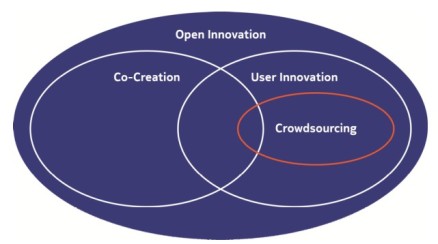
Erkinheimo, P., & Harjanne, K. (2011). Idea Crowdsourcing at Nokia – 12 months wiser. Retrieved from http://www.ideasproject.com/servlet/JiveServlet/previewBody/8915-102-1-2570/OISPG 2012 FINAL.pdf
The above representation is one of the few which clearly links co-creation to crowdsourcing, open innovation and even user innovation). It’s adapted from Schenk & Guitard (2009), whose visualization of crowdsourcing is also above, and stems from a fantastic paper of a young PhD-student at Stanford. The Finish student Tanja Aitamurto is conducting research about pretty much the same topics than I do, and she works closely with companies like Nokia. “The notion of co-creation combines user innovation and crowdsourcing and also is a subset of the open innovation concept“, she says in the paper.

Geiger, D., Seedorf, S., Nickerson, R., & Schader, M. (2011). Managing the Crowd : Towards a Taxonomy of Crowdsourcing Processes. Seventeenth Americas Conference on Information Systems (pp. 1-11). Detroit, Michigan.
An interesting visualization is this one because it’s the only one to actually show the “active” role that should be played by the crowdsourcing intermediary. This one is not only responsible for having a crowd of potential contributors, but also to issue the call (“source contributions“) and to aggregate the content (“aggregate contributions“). Being actively involved in crowdsourcing in my day job, I can say that this latter stage is very important for the organizations who sponsor crowdsourcing initiatives, because it’s easy to get lost, it’s time-consuming if contributions are incomplete etc. You’ll find Geiger et al.’s paper, which is based on a review of 46 examples of crowdsourcing-based organizations, here.
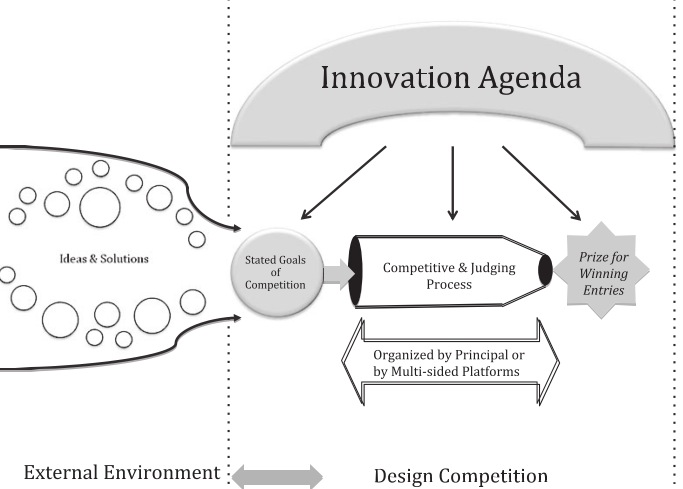
Lampel, J., Jha, P. P., & Bhalla, A. (2012). How Design Competitions Are Changing Innovation. Academy of Management Perspectives, 26(2), 71–85.
In their paper How Design Competitions are Changing Innovation, Lampel et al. provide an interesting analysis of the evolution of crowdsourcing for innovation. The above illustration is their representation of the process, but their paper goes beyond that: they identify several key differences in “design competitions” (or “innovation contests“) and illustrate them by giving examples of famous contests. For example: the Netflix Prize was a contest with narrow focus, whereas DARPA’s driverless vehicle competition was a contest with broad focus. Other key differences include the architecture, design, assessment or the design of contests, but also underlines the growing role played by “external actors such as technology brokers, project promoters, and innovation intermediaries.” I recommend this read for innovation scholars!
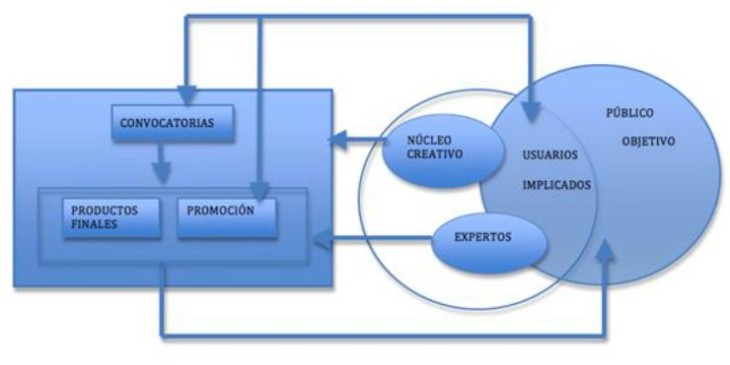
Telo, A. R., Sanchez-Navarro, J., & Leibovitz, T. (2012). ¡ ESTA PELÍCULA LA HACEMOS ENTRE TODOS ! Crowdsourcing y crowdfunding como prácticas colaborativas en la producción audiovisual contemporánea. Icono 14, 1(10), 25–40
This one is in Spanish! Actually the only English part is the abstract, which starts with: “This paper focuses on the analysis of a series of emerging creative practices of particular relevance in the field of audiovisual media production, particularly those that tend to cluster around two terms of increasing popularity: crowdsourcing and crowdfunding.” In their paper Crowdsourcing y crowdfunding como prácticas colaborativas en la producción audiovisual contemporánea, a group of Spanish researchers describe crowdsourcing and crowdfunding as novel production methods in the film industry. They cite examples like A Swarm of Angels or the great Life In A Day, describing how these projects have integrated users in the creative process. For those of you who feel like reading about crowdsourcing and the creative industries in Spanish, I recommend it!

Prpić, J., & Shukla, P. (2013). The Theory of Crowd Capital. Proceedings of the Hawaii International Conference on Systems Sciences #46
In “The Theory of Crowd Capital,” John Prpic and Prashant Shukla from the Simon Fraser University in Vancouver present an interesting model of leveraging the crowd in organizations. “We conceptualize Crowd Capital as a heterogeneous organizational knowledge resource, generated by the organization’s Crowd Capability,” they say, further explaining that “Crowd Capital is an organizational level capability that is defined by the structure, content, and process of an organizations engagement with the dispersed knowledge of individuals — the Crowd.” An interesting paper, one more to see the crowd as a significant organizational resource… and crowdsourcing as an organizational capability.
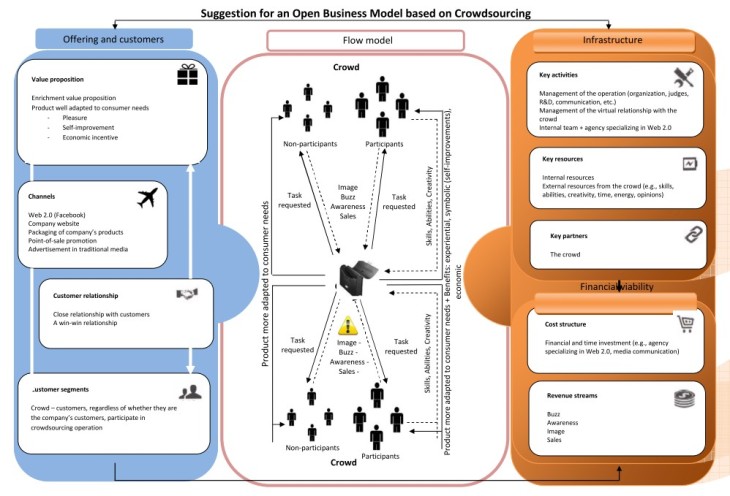
Djelassi, S., & Decoopman, I. (2013). Customers’ Participation in Product Development through Crowdsourcing : Issues and Implications. Industrial Marketing Management, 42(5), 683–692.
In their paper about crowdsourcing in new product development, two researchers from Lille, Souad Djelassi and Isabelle Decoopman, look at crowdsourcing in a very broad perspective. Based on five case studies of consumer goods companies’ crowdsourcing initiatives, they interviewed both participants and managers to better understand this phenomenon in France. They also outline organizational constraints and fears that crowdsourcing generates, but undeline that crowdsourcing can create value for both firms and customers. Donwload their article here.
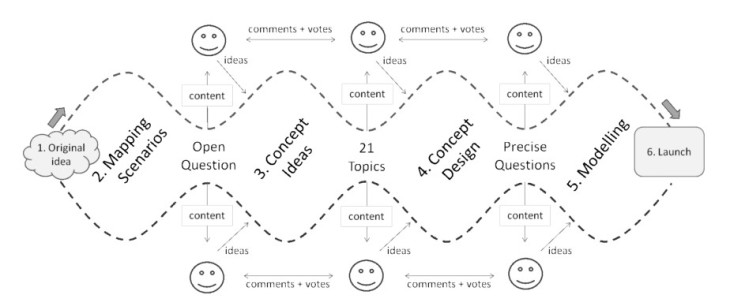
Saldanha, F. P., Cohendet, P., & Pozzebon, M. (2014). Challenging the Stage-Gate Model in Crowdsourcing : The Case of Fiat Mio in Brazil. Technology Innovation Management Review, (September), 28–35.
In this paper, the authors have made case study of the famous “Fiat Mio” initiative which was conducted in Brazil a couple of years ago. This project involved more than 17,000 participants from 160 different nationalities over 15 months, and about 11,000 ideas were selected and developed to create a concept car using a collaborative process. The authors propose a new model – the accordion model – to help maximize the beneficial inputs of the crowd. “Whereas the stage-gate process relies on a “funnel” […] in this article, we suggest that crowdsourced projects are more akin to a process that articulates a succession of broadening and funnelling periods,” the authors explain. It’s not a giant theoretical leap, bet an interesting read to better understand crowdsourcing and co-creation.
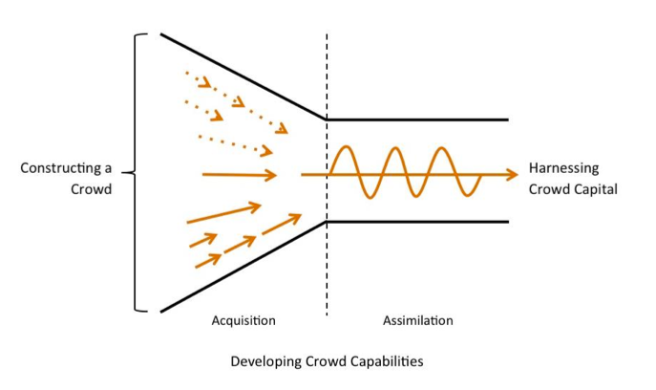
Prpic, J.; Shukla, P.; Kietzmann, J.H. and McCarthy, I.P. (Forthcoming). How to Work a Crowd: Developing Crowd Capital Through Crowdsourcing, Business Horizons.
In “How to Work a Crowd: Developing Crowd Capital through Crowdsourcing,” to appear in Business Horizons soon, John Prpic, Prashant Shukla and colleagues from the Simon Fraser University in Vancouver build on their early works around Crowd Capital Theory to present the “Crowd Capital Perspective,” pictured above. “We […] present a three-step process model for generating crowd capital. Step one includes important considerations that shape how a crowd is to be constructed. Step two outlines the capabilities firms need to develop to acquire and assimilate resources (e.g., knowledge, labor, funds) from the crowd. Step three addresses key decision-areas that executives need to address to effectively engage crowds,” the abstract explains. A very useful framework which I can imagine to be cited by many in the future, including myself for work on crowdsourcing!
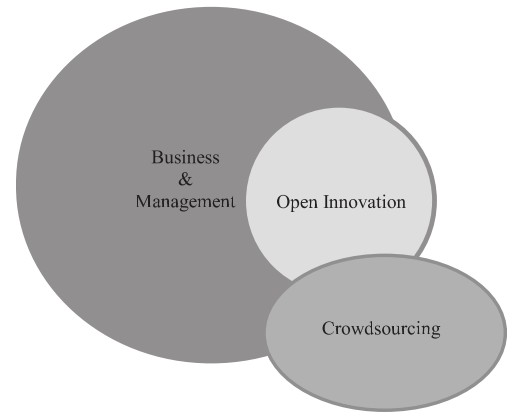
Hossain, M. (2015). Crowdsourcing in business and management disciplines: an integrative literature review. Journal of Global Entrepreneurship Research, 5(1), 21.
This paper is one I don’t quite agree with! Not in terms of its overall findings – like the fact that most of the qualitative crowdsourcing-focused articles used single case method and most of the quantitative studies relied on online survey over a single crowdsourcing platform, or that the literature about crowsdsourcing is limited to a number of countries – but in terms of conceptually positioning crowdsourcing in relation to open innovation. Professor Hossain says that “crowdsourcing is not a concept under the umbrella of open innovation [and] it can merely be claimed that crowdsourcing has overlaps with open innovation. Crowdsourcing [falls] partially under [Business & Management] disciplines.” For me, both are not mutually exclusive, and crowdsourcing is very much overlapping with open innovation. Anyway, the other paper’s findings are really great, get it here.
-
CO-CREATION
Similar to the term crowdsourcing, there are a lot of definitions of co-creation out there. I don’t think one can impose one or the other as a universal definition; some have a quite universal view of co-creation, others apply it to specific fields like product developement: “The act of involving consumers directly, and in some cases repeatedly, in the product creation or innovation process. Companies engage with consumers on initial product concepts and ideas, and they use consumers as a resource throughout the product development life cycle” says Doug Williams from Forrester Research on the Co-Creation Forum’s website.
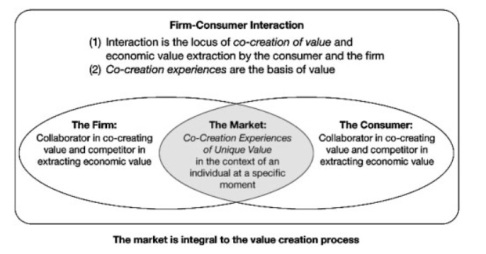
Prahalad, C. K., & Ramaswamy, V. (2004). Co-creation experiences: The next practice in value creation. Journal of Interactive Marketing, 18(3), 5-14. doi:10.1002/dir.20015
Back to the basics! the first to really spread the word about co-creation were the late C.K. Prahalad and Venkat Ramaswamy. The above figure shows co-creation of experiences as an intersection between companies and consumer at a specific point in time. The next figure is drawn from a real-worl case…

Ramaswamy, V. (2008). Co-creating value through customers’ experiences: the Nike case. Strategy & Leadership, 36(5), 9-14
…which is the Nike case. It’s basically the same representation but details Ramaswamy’s Dialogue/Access/Resik-Return/Transparency (DART) model, which is supposed to guide companies in applying the co-creative logic. The paper about Nike highlights the NikePlus platform which, together with corporate partner Apple, gathers runners around the experience of running, sharing with friends and connecting with local communities of sportsmen.
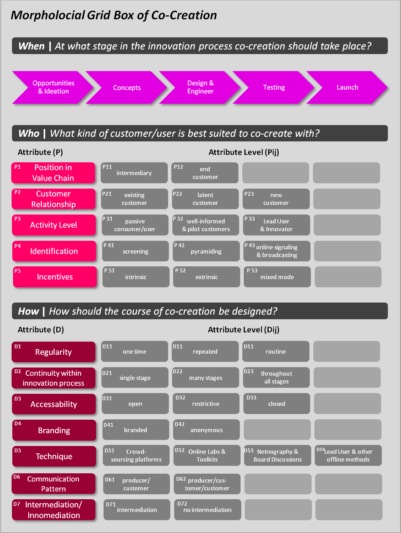
Bartl, M. (2009). The Morphology of Co-Creation. MichaelBartl.com. Retrieved October 16, 2011, from http://www.michaelbartl.com/co-creation/article/the-morphology-of-co-creation/
I already talked about Michael Bartl, CEO of Hyve AG, in this blog post about virtual communities in market research. The representation that you can see here is drawn from his website doesn’t only show what co-creation is, but also how it can be implemented and who should be involved. The numerous attributes give executives hints about what decisions to take when engaging in a co-creation initiative… and make clear that it is not a simple endeavour.
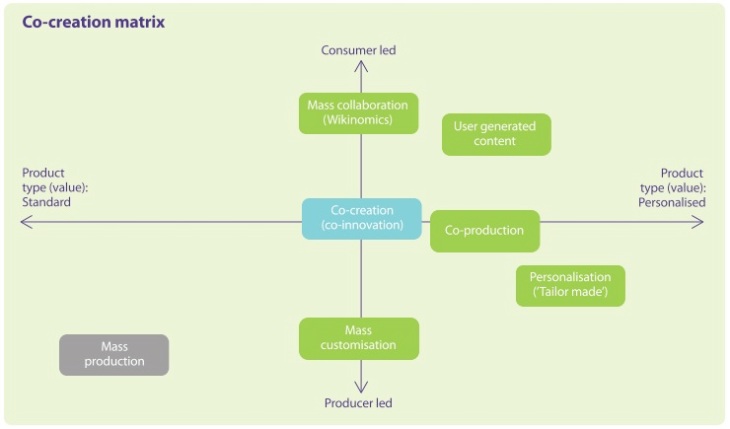
Humphreys, P., Samson, A., Roser, T., & Cruz-Valdivieso, E. (2009). Co-creation : New pathways to value. An overview (pp. 1-22)
This representation stems from an academic paper from the people from Promise Corp, a British co-creation consultancy. Called Co-creation: New Pathways for Value, the document is actually a visually pleasant version of an academic paper 😉 and features visualisations such as the above “co-creation matrix” that compares different consumer-engagement techniques according to the role of the firm (y-axis) and the type of value created (x-axis). It looks cool… but doesn’t really differentiate co-creation from other techniques (rather does it show how the different techniques (in green) are versions of co-creation).
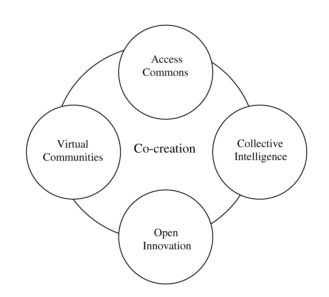
Zwass, V. (2010). Co-Creation: Toward a Taxonomy and an Integrated Research Perspective. International Journal of Electronic Commerce, 15(1), 11-48. ME Sharpe. doi:10.2753/JEC1086-4415150101
In a highly interesting paper, Vladimir Zwass discusses current research and established a taxonomy of co-creation, basically distinguishing sponsored and non-sponsored co-creation. But before going into these details, he defines the “Intellectual Space of Co-Creation Research” (above representation) which -as the previous one from Promise- indicates that co-creation is at the intersection of related trends. “Co-creation is underwritten by several developments that have accreted research literatures and traditions“, he says.
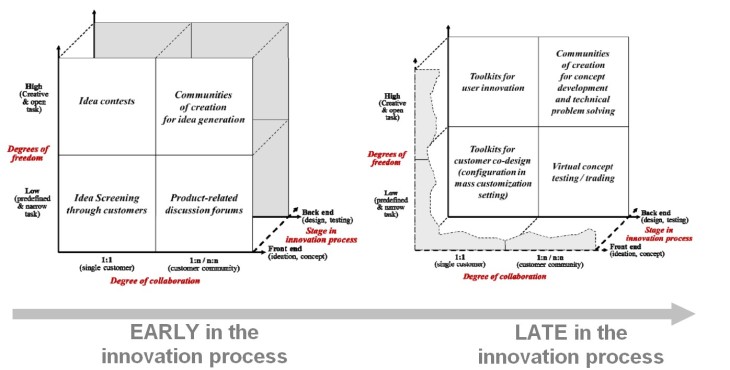
Piller, F., Ihl, C., & Vossen, A. (2011). A typology of customer co-creation in the innovation process. New Forms of Collaborative Innovation and Production on the Internet (pp. 31-61). Göttingen: Universitätsverlag Göottingen.
This is the visualization I used for my Master’s Thesis: a distinction of different co-creation methods on the consumer-side. Piller, Ihl & Vossen distinguish three dimensions: the stage of the innovation process, the degree of freedom the the company leaves to the consumer, and the degree of collaboration. It’s a great categorization, even though it’s less visual than some of the other representations in this post. For example, the authors underline that “idea contests overcome a core challenge for firms when opening the innovation process: how to incentivize customers to transfer their innovative ideas“. The example which illustrates idea contests is Fujitsu-Siemens, that I mentioned in another post about Siemens’ co-creation initiatives.
-
OPEN INNOVATION
Henry Chesbrough defines Open Innovation as “a paradigm that assumes that firms can and should use external ideas as well as internal ideas, and internal and external paths to market, as the firms look to advance their technology” (2003). I think this openness is not only applicable to technology (as innovation is not only linked to R&D) but also to design or marketing. As the following illustrations show, opening the innovation funnel can take various forms. 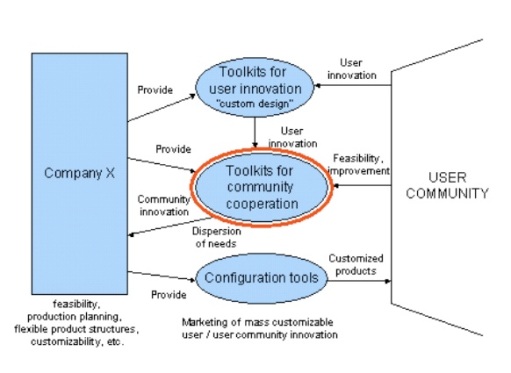 In a paper about online communities and people who participate in them, Ahonen & Antikainen (2007) discuss peoples’ motivations to participate and how online tools can be helpful to involve people. The above representation shows what toolkits exist to enable user innovation, community cooperation and mass customization via the web. The paper concludes by citing examples of open communities like Bookmooch, InnoCentive or InnerTee (that obviously doesn’t exist anymore). I must admit that I could have put this vusial in either one of the preceding categories, but since it shows different possible tools for Open Innovation, it’s probably best here. Other, more frequent visualizations of Open Innovation follow…
In a paper about online communities and people who participate in them, Ahonen & Antikainen (2007) discuss peoples’ motivations to participate and how online tools can be helpful to involve people. The above representation shows what toolkits exist to enable user innovation, community cooperation and mass customization via the web. The paper concludes by citing examples of open communities like Bookmooch, InnoCentive or InnerTee (that obviously doesn’t exist anymore). I must admit that I could have put this vusial in either one of the preceding categories, but since it shows different possible tools for Open Innovation, it’s probably best here. Other, more frequent visualizations of Open Innovation follow…
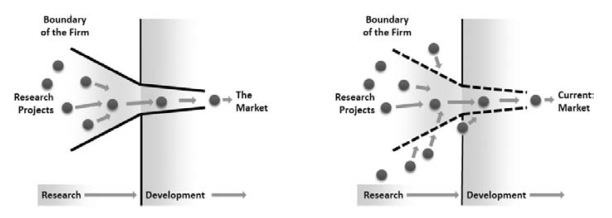
Leimeister, J. M., Huber, M., Bretschneider, U., & Krcmar, H. (2009). Leveraging Crowdsourcing: Activation-Supporting Components for IT-Based Ideas Competition. Journal of Management Information Systems, 26(1), 197-224
This paper of Leimeister et al. (2009) is praised for being one of the few to be based on experimental data. Their research is based on the SAPiens community of student SAP users who participated to an idea competition explores mechanisms to foster participation on those communities: from skypecasts to tag clouds, from user profiles to community ratings. They conclude that these techniques have a complementary role to play in community activation and member participation. The above representation of Open Innovation is just part of the introduction 😉
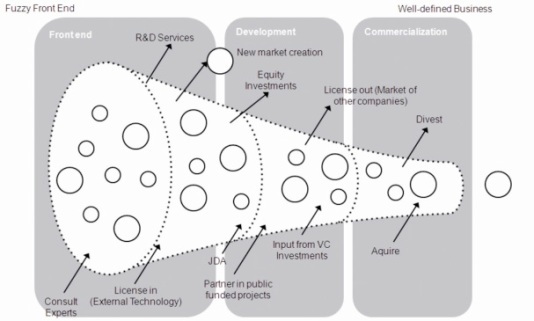
Reger, G., Adelhelm, S., & Braun, A. (2009). Open Innovation and Customer Integration: Opportunities and Risks. First International Conference on Strategic Innovation and Future Creation (pp. 1-9). Malta
Another funnel-like representation, that still focuses a lot on technology/partners and not a lot on consumers. The article content is very much about consumer input, though: “the role of the customer changes increasingly from that of a passive consumer to an active co-innovator, co-producer and co-designer of the innovation process“, it says in the early part of the article (from which this figure is taken). But beside underlining the oppotunities of Open Innovation, it also highlights some risks like dependency towards external idea providers or misuse of resources by users. Talking about this, I highly recommend this paper about negative side effects of customer integration.
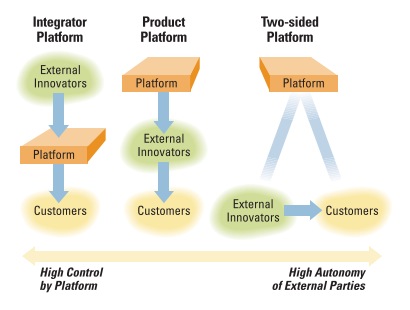
Boudreau, K. J., & Lakhani, K. R. (2009). How to Manage Outside Innovation. MIT Sloan Management Review, 50(4), 69-76
A visual from Boudreau & Lakhani’s paper in MIT’s Sloan Management Review. It’s a very synthetic paper about ways to involve external innovators… and as always the answer is: it depends! Based on how much control a company wants to have and how people will be involved (i.e. competition vs. collaboration), different models are possible. Examples of Integrator Platforms are InnoCentive or Threadless, examples of Product Platforms are Wikipedia or Google Android, and examples of Two-Sided Platforms are eBay or Communispace. I like the above visualization because it goes beyond mere “openess” and shows that differences exist between strategies.
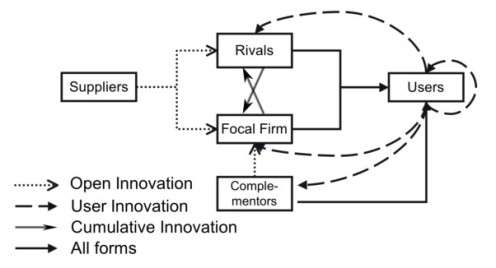
West, J., & Bogers, M. (2010). Contrasting Innovation Creation and Commercialization within Open , User and Cumulative Innovation. Academy of Management Conference (pp. 1-39). Montréal, Québec, Canada.
In a great paper about different the new innovation paradigms (Open Innovation, User Innovation and Cumulative Innovation), West & Bogers differentiate them from traditional, vertically integrated innovation. “The OI, UI and CI streams focus on innovation that combines knowledge created at different loci, across multiple stakeholders in a value network“, they say just before illustrating this with the above figure. Interestingly, they describe crowdsourcing as “a general of inbound Open Innovation“, citing P&G as a good example, and InnoCentive as a typical intermediary, and co-creation as “an extension of UI-input or OI-inbound that involves joint development of an innovation […] between a firm’s employees and external stakeholders such as users“.
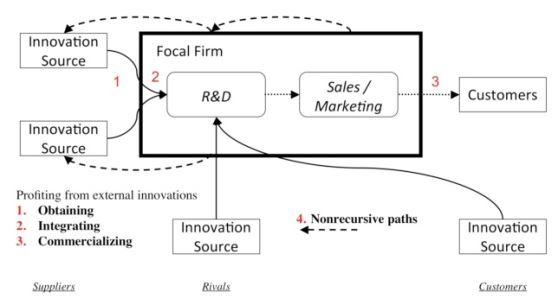
West, J., & Bogers, M. (2011). Profiting from External Innovation : A Review of Research on Open Innovation. 9th International Open and User Innovation Workshop (pp. 1-47). Vienna, Austria. Retrieved from http://ssrn.com/abstract=1949520
The above figure comes from an extensive literature review led by Joel West and Marcel Bogers about Open Innovation. The authors highlight how research is plentiful in the early phases of Open Innovation (like obtaining innovation), and later phases like integration and commercialization are less explored. “Identifying and acquiring external innovations is only half the battle“, they say. It’s interesting to see that the customer is only at the end of the innovation process… even though the paper cites Piller & Walcher or Füller et al. (i.e. customer community-based innovation intermediaries) as sources for innovation!

Bogers, M., & West, J. (2012). Managing Distributed Innovation: Strategic Utilization of Open and User Innovation. Creativity and Innovation Management, 21(1), 61-75.
This one is also taken from a paper by West & Bogers, published in 2012 in creativity and innovation management. Their article reviews two streams of research that criticize the traditional, vertical approach of innovation: open innovation and user innovation. They explain that these two concepts are different as in “user innovation […] the questions and findings revolve around the utility gains for the user rather than any pecuniary benefit”. I like the above visualization because shows that innovation is not only about invention (having creative ideas) but also about implementation by the firm. They say in their article that “open innovation research considers all possible combinations and recombinations of externally created innovations, as long as the firm can successfully commercialize the insourced innovation“. They also talk about crowdsourcing and co-creation, but offer no visualizations of it as these concepts are not the focal points of the paper.
In Managing Unsolicited Ideas for R&D, three professors from London’s Imprial College share results of their research about unsolicited idea management in big firms. They underline that “in practice, many organizations find it difficult to deal with unsolicited ideas because of high quantity, low quality, and the need to transfer IP ownership” and identify “practices that allow organizations to meet these challenges and therefore realize some of the potential of unsolicited ideas for R&D.” The above illustration represents the outside-in process of managing ideas, and it’s interesting to notice the “inwards phase” which is rarely addressed in open innovation research. Another warmly recommended read for you.
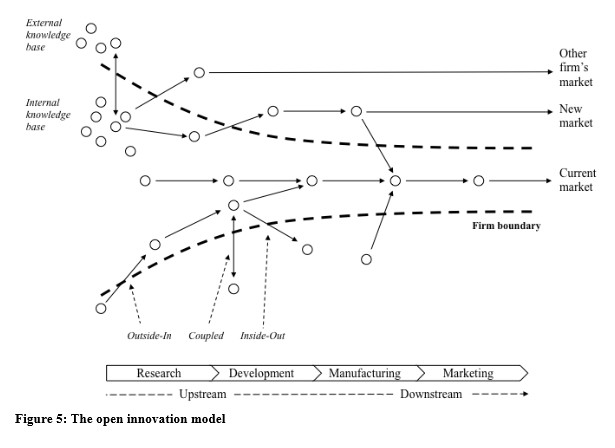
Chesbrough, H., Bogers, M. 2014. Explicating open innovation: Clarifying an emerging paradigm for understanding innovation. In: H. Chesbrough, W. Vanhaverbeke, J. West, eds. New Frontiers in Open Innovation. Oxford University Press, Oxford, forthcoming.
The above figure – back to the basics – comes from “New Frontiers in Open Innovation“, a book which will be published October 2014 by OUP and seeks both to integrate a decade of prior research on open innovation and to engage the academic community in fostering new research. The figure is part of the first chapter, “Explicating Open Innovation: Clarifying an Emerging Paradigm for Understanding Innovation,” written by Henry Chesbrough and Marcel Bogers. in which Open Innovation is defined as “a distributed innovation process based on purposively managed knowledge flows across organizational boundaries, using pecuniary and non-pecuniary mechanisms in line with theorganization’s business model.” A highly useful book for all academics (and beyond) who seek to understand open innovation a decade after the popularization of the concept. – End note: I’m sure I’ve missed a bunch of cool representations of each of the above topics. You must know that I’ve deliberately chosen to feature only English-speaking illustrations. Please feel free to suggest some interesting visualizations I might have missed, I’d be glad to add them !

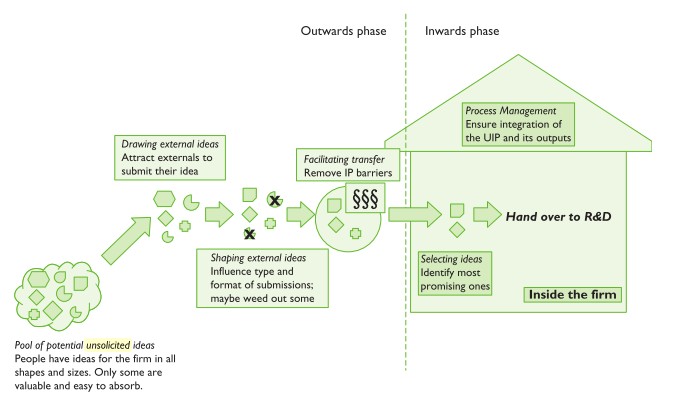
Hi Yannig, great you are trying to pulle it all together. did you read our whitepaper?
Click to access FS_Whitepaper-Co-creation_5_Guiding_Principles-April_2009.pdf
Martijn
Thank you Martijn for the link, I think I already stumbled upon it in the last months, but I hadn’t printed it out to read it. That’s done now! You don’t show a proper representation of co-creation, crowdsourcing or open innovation though – and it probably wasn’t the objective of the whitepaper. However, you give a great link to Lakhani & Panetta’s paper that I had already heard about (in Tournaments for Ideas, by Morgan & Wang (2010)) but I couldn’t lay a hand on it! Thanks for that ! 😉
Hi Yannig,
Thanks for pulling this.
François Pétavy will be here at coCreationcamp to share some views.
Looking forward to these.
Cheers,
Alok Nandi
Thanks for the heads up, Alok!
Just seen this – brilliant! Will definitely follow your posts & as for me: I’m looking at crowdsourcing & philanthropy in UK organisations, so there is some common themes. V. happy to share links & articles I’ve found, will keep posted!
(en francais aussi)
Just writing my master-thesis on “creative crowdsourcing”
– thanks for the helpful blog, Yannig
If you happen to receive this message, I am starting to work on my masters thesis investigating Crowdsourcing particularly with a social innovation focus. I’d love to check out what you produced.
This is a great post. I only wish you’d been able to write it four years ago, it might have saved me a lot of trouble trying to work through all the different definitions for the same terms 😉
A couple of comments:
1. I notice you didn’t include co-design, is there a reason? In my experience it’s another can of worms – some definitions imply it’s pretty much the same as co-creation, some suggest it’s more like user-centred design, and others insist it’s something unique. Would be interesting to get your take on that.
2. The definition of open innovation that you use is standard amongst the kind of literature you’re searching. But there are other fields (especially outside academia) where it’s much more closely aligned to the open-source movement, i.e. it doesn’t count as open-innovation if the methods and results aren’t also open.
Keep up the good work!
Matt
These are some very interesting points Matt! I must admit that I didn’t even think about co-design, probably because I never came across some visual representations of the “co-design process”. I found a definition of it in Ahonen & Antikainen (2007): “While communities of creation address the creation of a new solution space, communities of co-design use an existing one for the purpose of configuration (of a customized product)”, they say. It seems that co-design is linked to mass customization in a way (Piller & al. 2005) don’t you think?
Hi Yannig,
I have to admit that’s one definition I haven’t seen before, though it’s true that mass customisation literature talks about the co-designer a lot. This is from the CoDesign journal, which is the definition I’ve been using:
“co-design is a specific instance of co-creation… [it] refer[s] to the creativity of designers and people not trained in design working together in the design development process.”
Sanders, E.B-N and Stappers, P.J. (2008), Co-Creation and the New Landscapes of Design’, in CoDesign, 4(1), pp. 5-18
This makes it a lot more about actual design, rather than just configuration of an already existing product, as Ahonen and Antikainen seem to imply. But it’s also true to say that there are very few ‘real world’ examples of this definition being successfully implemented (something that Sanders and Stappers admit themselves).
I’ve come across similar presentations these days while researching co-creation, but I have to say I am very critical of some of them. In my view, co-creation should be understood as joint value creation, rather than involving customers in new product/service development, that is actually defined as co-production. Therefore, co-creation should go further and redefine the entire value creation process from scratch, focusing on the way customers create value and how the firm can take an active role in this process. I also think that firms that want to get involved in co-creation should acknowledge that the line between employees and customers is thinner and that the firm’s customers are actually valuable resources.
Thank you for your comment Carmen. I agree with you, everything tends to be called co-creation today, from crowdsourcing to market research… but it’s a trend, and laymen embrace it like this. What you say makes me think about Cova’s recent work around Alfa Romeo. He asks the question whether (real) co-creation isn’t more painful for the company that initiates it than for customers… Really great stuff (I don’t know whether it’s published yet, but its in the pipes 😉 )
Hey,
I wanted to thank you for your paper it is very helpful and clear.
I am a Bachelors student at the University of Geneva and I am currently writing a thesis on Co-creation. However, I am of Indian origin and I have decided to focus on co-creation in India. My teacher wants me to use a netnography approach by studying forums, blogs and online communities.
As I can see, you have a lot of knowledge in this field and I would like to ask you if you could give me some examples of co-creation in India and if you know of any nice active forums for this purpose.
I am of French and English mother tongue so any information is good for me.
Thank you very much!
Hi Raj,
thank you for your comment. Have you read The Power of Co-Creation? It’s more managerial than academic, but it features a lot of examples of co-creation in India. You should buy it, here’s a blog post about it on my blog (https://yannigroth.wordpress.com/2011/01/18/those-who-embrace-co-creation-are-savvy-innovators/) and on eYeka’s blog (http://en.eyeka.net/2011/01/the-power-of-co-creation/).
Hope this helps,
Yannig
Hi Yanning, I have been following your blog for sometime now. I myself is also looking for a PhD on crowdsourcing. I am preparing my research proposal for that matter and just wondering if netnography is the most suitable approach for this type of reasearch…. what about multi case study analysis….. or anything else for that matter??? would appreciate your thought. Thanks Abdur
Hello,
It actually depends on what you intend to do i.e. Intend to prove. You probably find out after the first or second year, so I suggest you start reading and find out what gaps are in the literature. Only then you’ll be able to tell what methodology to use
Dear Yannig,
Nice blog. Are you familiar with http://alexandria.tue.nl/extra2/710973.pdf
And what is your opinion on this phd thesis
Hi Sander, thanks for yuor comment. I know the thesis, it once was on my reading list… but I abandonned, being too busy writing my own 🙂 Do you have an opinion on it?
I am making a documentary about crowdsourcing, heres a quick review of how far I’m at the moment. Please give me feedback how i can enhance it I would try to use your theories above in their in some way to get a brigther vision on what crowdsourcing is all about. http://www.youtube.com/watch?v=NVt6587GGg4#t thanks in advance for your feedback, would preciate it alot.
[…] co-creation roadmap, which is another role of the co-creation manager. To go further, check out more visual representations of open innovation (as well as co-creation and […]
Hi Yannig
Great post. I would consider crowdsourcing or co-creation as methods within open innovation (together with a few others methods). Why do you consider them as separate to and not part of open innovation? I see (outside-in) open innovation as a way to innovate by making use of external input into your innovation process, hence my question.
I totally agree with you, and it’s part of my dissertation to present it this way. I see crowdsourcing as a way to access external knowledge, and co-creation as a way to leverage this access to create value. Thanks for your comment!
[…] roadmap, which is another role of the co-creation manager. To go further, check out more visual representations of open innovation (as well as co-creation and […]
[…] Crowd Capital Theory – featured here… […]
Awesome integration of the theories of “crowd” out. And very pleased to be a part. 🙂 Regards from Vancouver.
-Prashant.
[…] nouveau. Donc je pense que le concept est trop flou pour être étudié avec rigueur (regardez ces quelques représentations académiques de co-création), et j’ai donc décidé de me concentrer sur le […]
[…] roadmap, which is another role of the co-creation manager. To go further, check out more visual representations of open innovation (as well as co-creation and […]
[…] – traduction à partir d’une citation de Doug Williams : « L’acte d’impliquer directement les consommateurs, et dans certains cas à […]
[…] Source : traduction libre, citation de Doug Williams […]